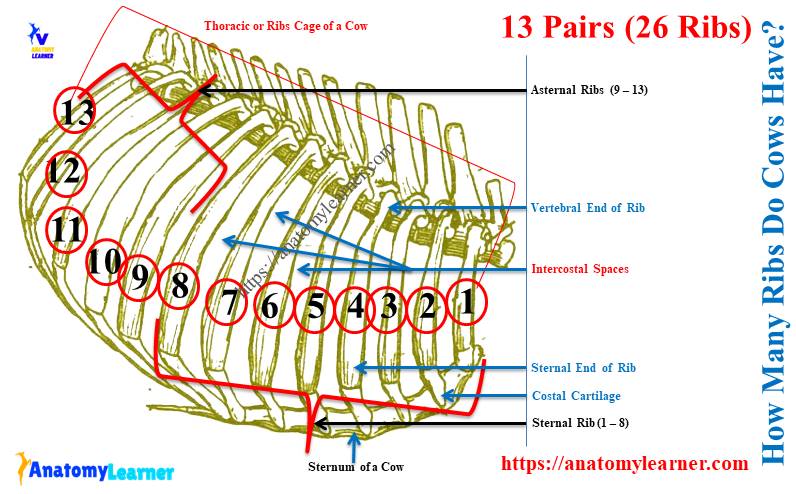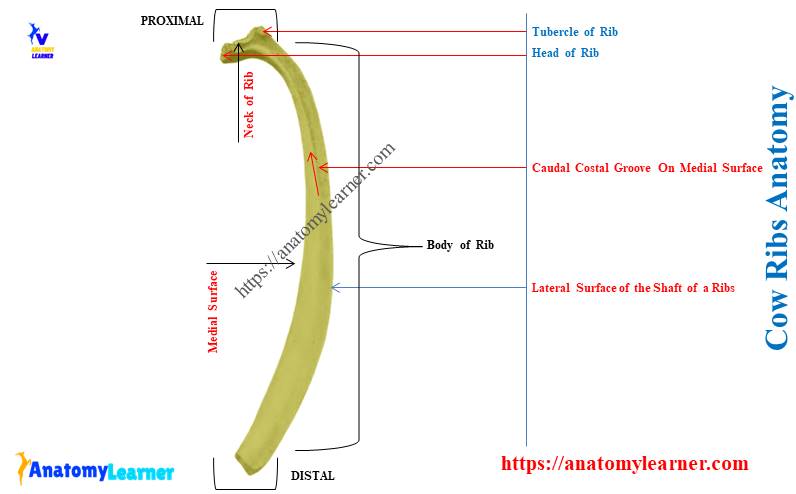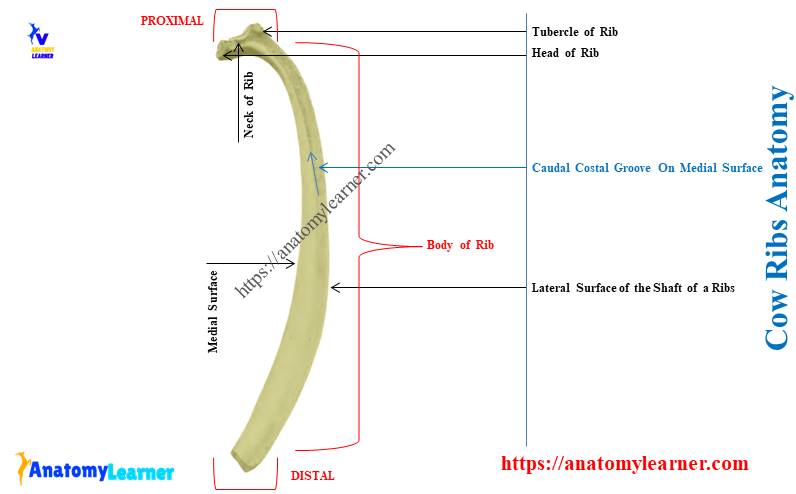The external appearance and number of cow ribs differ slightly from those of dogs and horses. Being a beginner veterinary student or farm owner, you may have the question – how many ribs does a cow have?
Here, I will show you the exact number of ribs from a cow thoracic cage with a labeled diagram. You will also find the variation in the number of ribs in various animals like dogs, pigs, horses, goats, and deer.
Quick answer: cows have 13 pairs of ribs, of which 8 are sternal, and 5 are asternal. Typically, cow ribs are longer, wider, flatter, less curved, and less irregular in form than in the horse.
Here, you will also know why few bovine ribs are sternal and few are asternal. Let’s continue this article to learn the structure of a typical rib from a cow or ox (bovine).
How many ribs does a cow have
First, let’s see the cow skeleton labeled diagram where I tried to focus on the rib or thoracic cage. I have also marked every single rib from the thoracic region of the cow’s skeleton.
These ribs are part of the axial skeleton of the cows. Let’s count them, and you will find 13 ribs on each side (right and left lateral aspect) of the cow’s thoracic cage.

Thus, there are total 26 ribs in the thoracic cage of a cow. The general structure of these 13 pairs of ribs is similar, but the length, width, and curves may vary from each other.
“Ribs arrange serially in pair and correspond in number to thoracic vertebrae.”
Let’s see the numbers and general appearance of the cow ribs from Table 1 –
| Cow ribs | Features |
| How many ribs do cows have? | 13 pairs (9 pairs sternal and 5 pairs asternal) |
| Smallest ribs of a cow | First, second, and thirteen, |
| Largest and widest ribs | Eight, ninth, and tenth ribs |
| Wide increase at | Middle of the ribs (6 – 10) |
| Small intercostal space formation | At middle |
| Wide intercostal space at | Anterior and posterior parts of the series |
| Typical head on a proximal end | Present in all ribs |
| Typical tubercle on a proximal end | Present in all ribs (except the last two) |
Thus, you will find a great variation in the different ribs of a cow. And you might be familiar with some terms like asternal, sternal, intercostal spaces, and various structures of ribs from their proximal and distal ends.
Cow ribs anatomy
Cow ribs (or costae) are elongated, curved, modified long bones that are proximally articulate with two contiguous vertebrae. Again, they distally articulate with the sternum with the help of cartilage.
A typical cow rib present –
- An elongated, curved body or shaft, and
- The two extremities (proximal vertebral and distal sternal),
So, first, let’s see the anatomy or osteological features of the body of a cow rib.

Osteological features of the body of a cow rib
The body of the cow rib is a bandlike structure that varies in length, breadth, and curvature. You will see a twisted ventral part in the cow rib, which inclines medially.
The ventral extremity will rise if you keep a cow rib on the table with its lateral surface.
The body of the cow rib has two surfaces and two borders –
- Lateral and medial surfaces, and
- Cranial and caudal borders,
Here, the lateral surface of the rib’s body is convex in length and transversely. You will see a longitudinal groove on its cranial part.
The medial surface of the body is concave and smooth in its length. Again, the medial surface is rounded from side to side.
The caudal border of the medial surface represents a distinct costal groove. But how many costal grooves does a cow rib have on its caudal border?
You will find one costal groove on the caudal part of the medial surface of a cow rib. This coastal groove is very distinct dorsally and faded out at the middle parts.
The intercostal vessels and nerves pass within this caudal costal groove of the cow rib.
As there are two surfaces in the body of a cow rib, typically, you will find two borders. Here, the cranial border of the rib’s body is thick and literally concave. Again, the caudal border is convex and possesses a costal groove.
Extremities of cow rib
The vertebral extremity of a cow rib represents 3 important osteological features –
- A rounded and larger head,
- The constricted neck, and
- A small body elevation or tubercle of the ribs,
You will find two convex articular surfaces or facets on the head – cranial and caudal. These two articular facts of the ribs articulate with the bodies of two adjacent thoracic vertebrae.
But, you will find a little exception for the head of the first rib of a cow. It articulates with the caudal facet of the seventh cervical vertebra and the cranial facet of the first thoracic vertebrae.
To get a clear idea of how the rib’s head articulates with the body (facets) of thoracic vertebrae, you should know the structure of this vertebra. The below-mentioned article will provide a basic idea of the structure of a typical thoracic vertebra of a cow –
The neck of the cow rib is roughened dorsally and cranially. It articulates the larger head with the tubercles of a rib.
Now, the tubercle of a cow rib projects caudally at the junction of the head and neck. You will find a concave articular surface that articulates with the transverse process (TP) of a thoracic vertebra.
The ventral extremity of a cow’s rib is slightly enlarged and expanded. It is slightly roughened at the junction with costal cartilage.
“The distal concave end of cow rib forms a costochondral articulation with the costal cartilage.”
How do the head and tubercle of a cow’s ribs attach to the thoracic vertebra?
Suppose there are two thoracic vertebrae (cranial and caudal), and both possess cranial and caudal facets on their body. The caudal pair of facts of the cranial thoracic vertebra meet the cranial pair of facts of the caudal vertebra.
Thus, a larger and almost rounded articular surface is formed between the bodies of these two vertebrae. The head of the rib articulates within this larger and rounded articular surface of the corresponding thoracic vertebrae.
Both the transverse process of the cranial and caudal thoracic vertebrae possess facets on their lateral aspect. The tubercle of the rib will attach to the facts of the transverse process of the caudal thoracic vertebra.
Serial position of cow ribs
13 pairs of cow ribs do not equally show similar features. You will find a serial change in the 13 pairs of cow ribs. Let’s see these serial changes in the cow ribs –
- The length of the cow rib increase from the first to the tenth or eleventh then diminishes,
- You will find an increase in the width of the first to sixth ribs, then diminishes,
- Second to eight ribs show thin and sharp cranial borders; then other ribs possess thick and rounded cranial borders,
- From the fourth to eighth ribs, you will find the distinct groove on their lateral surface,
- The curvature of the cow ribs increases from the second to the seventh ribs,
- Again, the size of the head and tubercle diminish from the first to the last ribs,
The facet of the tubercle of the last rib is sometimes confluent with that of the head. This is because the facts of the last rib are small or flat or may be absent in some cases. Again, the last rib is more or less slender and irregularly curved than others.
How does the first rib of a cow differ from others?
The first rib of a cow differs from other ribs of the thoracic cage. It is the shortest, and the shaft is widened greatly toward its ventral extremity.
There is a smooth impression on the ventral part of the cranial border of the first rib. Within this smooth impression of the first rib, axillary vessels run.
There is no costal groove on the caudal border of the medial surface. Here, the head is larger, but the extension of the facets is unequal.
The neck is comparatively thick and short compared to other ribs of the cow’s thoracic cage.
What are the sternal and asternal ribs in a cow?
Now, it will be easy to understand a cow’s sternal and asternal ribs. If you see the thoracic cage of the cow, the ventral end (sternal end) of the cow’s ribs articulate with the sternum through cartilage.
The sternal end of some ribs directly articulates with the sternum with their own cartilage. Again, a few ribs articulate indirectly with the sternum.
- Sternal ribs – so these ribs of cows articulate with the sternum directly with the help of their own cartilage and are termed the asternal ribs.
The other name for sternal ribs is true ribs or costae verae.
- Asternal ribs – a few ribs reach the sternum indirectly by their costal cartilage, which joins with preceding cartilage; these are the asternal ribs.
But, in some other species, like dogs and pigs, you may find single or pairs of ribs that do not attach to adjacent cartilage. You will see these ribs at the end of the series, and they are considered as the floating ribs.
You will find one pair of small floating ribs in dogs and pigs.
How many ribs do goats have?
Like cows, goats have 13 pairs (total 26) of ribs in their thoracic cage, of which 8 are sternal, and 5 are asternal. The osteological features of the goat’s ribs are also similar to the cows.
But, the length, curvature, width, and structure of the head and tubercle from its proximal extremity are obviously smaller than the cow’s ribs. Sometimes, you may be interested in differentiating goat ribs from dog ribs.
There are significant differences between the dog and goat ribs. Let’s see how you will differentiate goat’s ribs from dog’s ribs in the next section of this article.
How to differentiate goat’s ribs from dog’s ribs?
You will find a similar number of ribs in a dog (13 pairs) where the first nine pairs are sternal, four pairs are asternal, and the last pair is floating. The body of the dog’s ribs is typically cylindrical and more curved than the goats.
You may get the basic idea of the osteological features of a dog rib from the below-mentioned article –
Now, let’s see the difference between dog and goat ribs from Table 2 –
| Features | Goat Ribs | Dog Ribs |
| Numbers | 13 pairs Sternal – 8 pairs Asternal – 5 pairs Floating – absent | 13 pairs Sternal – 8 pairs Asternal – 5 pairs Floating – 1 pair |
| Body of ribs | Flattened Less curved | Cylindrical More curved |
| Intercostal spaces | Unequal | Equal |
| Distance between head and tubercles | More | Less |
“The spaces between the adjacent ribs (costae) of cows are the intercostal spaces.”
How many pairs of ribs are in pigs?
There are fourteen or fifteen pairs (14/15) of ribs in the pigs. Among these 14 or 15 pairs, the first 7 pairs are sternal, and the rest 7 or 8 pairs of ribs are asternal in a pig.
You will see a distinct and fair curved in the proximal extremity of the pig ribs. The backward slope of the caudal ribs is slight.
The first ribs of a pig show some exceptional features. It is a prismatic shape and has a large sternal end. Again, the cartilage attached to the sternal end of the first rib is very short compared to other animals.
Table 3 shows the number of ribs in different animals like horses, deer, bison, and rabbits –
| How many ribs do animals have | Number of ribs |
| Horses | 18 pairs (36) |
| Deer | 13 pairs (26) |
| Bison | 14 – 15 pairs (28 -30) |
| Rabbit | 12 – 13 pairs (24 – 26) |
Cow ribs anatomy labeled diagram
Here, I will show you the different osteological features of cow ribs with the labeled diagram. Here, the diagram shows the flattened and curved shaft of the cow ribs.
The caudal border of the medial surface of the cow ribs shows the costal groove. Again, the diagram shows the distinct proximal head (with two articular facets), neck, and tubercles.
The cow ribs labeled diagram shows a concave articular facet on the tubercle. The labeled diagram also identifies the distal concave sternal end of a cow rib.
You may find more labeled diagrams of the ribs of various animals on social media of anatomy learners. Or you may find diagrams here in different articles of various animals (osteology section).
Conclusion
So, you have got the answer to your question – how many ribs does a cow have? The thirteen pairs of elongated, curved ribs form the skeleton of a lateral thoracic wall in a cow.
The first 8 sternal and the rest 5 asternal ribs arrange serially in pairs and articulate dorsally with vertebrae and ventrally with the sternum. A cow’s second to twelve ribs form a strong diarthrodial joint with the sternum with the help of costal cartilage.

